

1985:4
September 2, 1985
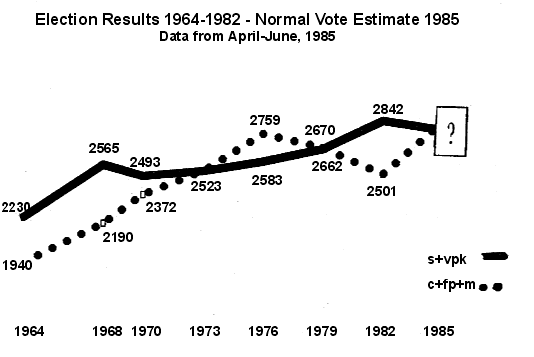
At stake in the Swedish election 1985 is the manning of a truly Big Government, albeit in a small state. The winners will directly control two thirds of the GNP, and indirectly much of the remaining economy. The incumbents are the Social Democratic Party (s), a nearly 100-year-old party that has spun a tight network of public services and auxilliary voluntary associations and unions into every corner of the Swedish scene. They are in the main supported by Sweden's small Communist party (vpk).
The opposition represents established bourgeois interests recently revitalized by the neoliberal ideas of our times and of the new moralism that calls for personal and family responsibility rather than public welfare institutions. They are split into four loosely aligned parties: the Conservatives (m), the Liberals (fp), and the former Agrarians called the Centerites (c), and the Christian Democrats (kds).
Outside the main battle is the small ecological party, the Greens, which is not expected to make much progress this year, nor gain any seats in Parliament.
If the 1985 election runs a normal course without unforeseen upsets, Sifo's pre-campaign calculations indicate that the non-socialist bloc will resume the pattern it evinced between 1964 and 1976 prior to the disappointments with the Fälldin governments of growing at a faster rate than the socialist bloc. This would make for an even election, not uncommon in Sweden.
A record number of voters — 6,248,300 — are entitled to take part in this year's national election, an increase of 117,300 over the 1982 elections. 356,200 are entitled to vote for the first time.
The Swedish election 1985 takes place on September 15. Campaigning started during the last week of July. Posters went up and party advertising appeared in earnest on August 10. By the same date party leaders were crisscrossing the country on daily campaign trails.
The Swedes have five weeks of vacation guaranteed by law. It is also a vacation from politics. Most went on vacation on or about Midsummer, i.e. the last week of June. The start of the summer vacation coincided with the passing of the Grand Old Man of the the Swedish welfare state, Tage Erlander, former Social Democratic Prime Minister. He received a sincere and moving party funeral at which his successor, Olof Palme, officiated.
The following is a brief summary of the course of the election campaigns as monitored by Sifo's polls.
Between June and August the Social Democrats took the lead in the polls. This period was ushered in by two important political events:
| The death and funeral of former Prime Minister Tage Erlander | |
| The electioneering debut in Almedalen |
We cannot precisely determine which of these two events contributed more to the swell of support for the Social Democrats during the summer, but in all probability, Erlander's passing was the more decisive.
A firm Social Democrat, the avuncular Tage Erlander was prime minister between 1946 and 1969. During his last years in office, he won the respect and affection of Swedes of all political persuasions. The whole country mourned his passing, and in so doing was repeatedly reminded of the welfare state constructed during his long reign. The red roses and scarlet banners that symbolize the Social Democratic party were recurrent motives on home screens during the TV coverage of his funeral, the eulogies commemorating his service to his country were often, if only indirectly, also commendations of his party. And presiding at the civil funeral service held in Erlander's honor was the present prime minister, Erlander's protege Olof Palme.
As Erlander's successor, Palme at that point became the one and only rallying figure of the Social Democrats. His stocks have climbed, not last among the party faithful. (His climb in popularity had actually begun before he officiated at Erlander's funeral: it started when he intervened in a strike among white-collar workers in May this year.) The percentage of voters who think Palme has become "better and better" at his job show that he made impressive gains between April and August.
Decency requires that one not speak ill of the dead, at least not immediately after their demise. This rule also applies to their deeds, in this case the construction and consolidation of the welfare state. An objective evaluation of Tage Erlander and his work will have to wait. Non-socialist campaigners, notably the Conservatives, thereby lost an important issue and defenders of untrammelled welfarism got a decided advantage.
In Almedalen on the outskirts of the city of Visby on the island of Gotland, Sweden's party leaders traditionally launch their campaigns in debuts geared to media coverage. This year the media got the impression that Palme is going to win the election, and at least through the month of August, they have based their subsequent interpretations of the political scene on this assumption. It was probably a mistake for Ulf Adelsohn not to come to Gotland and provide the media with his view of the election prospects.
During the first week of August it was disclosed that Palme's fee for a speaking engagement at Harvard had been exchanged for his son's scholarship at the university. No polls were taken at this time. It is possible that Palme's halo paled somewhat after this disclosure, but his standing in the polls remained higher than his showing in the Spring.
During the second week of August the International Monetary Fund's report on the state of Sweden's economy was made public. It had two political consequences:
| The socialist view that the economy is on the right road was seriouly questioned | |
| The need for economic restraints (tax increases and/or cutbacks in spending) became evident. Perhaps the government had presented them to the Fund as givens. |
This probably had temporary effects on support for the Social Democrats. When Sifo resumed polling on August 15 the Social Democrats received 43.7 percent. The figure had very likely been over 45 percent following their campaign take-off at Almedalen on Gotland. (Another research institute, Semka, began tracking earlier, and gave the Social Democrats 44.2 percent on August 11th.)
Following the disclosure of the IMF report Sweden's Minister of Finance Kjell-Olof Feldt published the entire text of the report and emphasized the parts that were favorable to his management of the the country's economy.
A lasting effect of the report has been the opinion that a tightening up of the economy is impending. This makes campaign promises of tax cuts less credible — a development that primarily weakens the Conservative platform.
This is the first time Ulf Adelsohn has been a non-socialist candidate for prime minister. Like the heroes of fairy tales, a candidate for political leadership must endure a series of trials and withstand temptations in order to prove to the people that he is a "real" man, a real leader and not just a figurehead. This part of a campaign can turn into a drama that the public follows with keen interest. Will he stand up to the test? Or will he lose control of himself and become ill-tempered or begin to weep (like Muskie)? Or will he try to place the blame on his campaign workers or on the media, insisting that he is getting unfair treatment? Depending on a candidate's reactions the electorate forms an impression of his character, of his knowledge, of his moral caliber. This process is deadly earnest and necessary before a leader can be acknowledged.
During two weeks in mid-August the media devoted a great deal of campaign coverage to Adelsohn's public statements: about the localization and status of the IMF, the plight of "Negroes" in South Africa, about his avowed willingness to take a swim in the water surrounding one of Sweden's nuclear power plants. There were also minutes from a meeting in Paris in which Adelsohn had participated (but had trouble remembering he had done so) where conservative leaders from various countries had supported placing American missiles in Europe. Adelsohn became a frequent subject of speculation in the press, which wondered: "Can he pass the test?"
On balance, he passed.
On August 27, the anti-Fund opposition gathered 10,000 demonstrators, mostly small businessmen, in the town of Jönköping. Electrolux' chairman, Hans Werthén, called the wage earner funds "a fatal cancer that begins on a small scale" and compared their performance to "third-rate investment companies." The government had had difficulties in securing professional managers to the five funds and they selected mostly economic journalists, knowledgable about the stock market and ideologically indifferent. Their investment record on the new jobs is not shining; however, it is too early to judge since the wage earner funds have been operating for only one year.
On behalf of Swedish TV's Channel 2, Sifo asked "Do you think that your party ought to strive to retain or abolish wage earners' funds?" In 888 interviews we received the following answers among —
|
|
% |
|||
|
Conservatives |
Abolish |
93 |
||
|
Liberals |
Abolish |
86 |
||
|
Centerites |
Abolish |
83 |
||
|
Social Democrats |
Abolish |
20 |
||
|
Communists |
Abolish |
18 |
||
The non-socialist bloc harbors a massive opinion for the abolition of wage earners' funds: 91 percent. There are more Social Democrats who want their party to retain rather than abolish the funds, but they do not constitute an absolute majority: they represent 45 percent. Among Social Democrats 20 percent favor abolishing the funds and as many as 36 percent do not know whether or not they want their party to keep the funds.
Opposition to the funds prevails among undecided voters: 56 percent state that they would want the party they will vote for to abolish the funds, 7 percent are for keeping them, and 37 percent have no opinion on the matter.
There is no majority among wage earners — neither among blue- nor white-collar workers in support of the funds:
|
|
Blue-collar |
White-collar workers |
||
|
Abolish |
42 |
66 |
||
On August 28 the two main contenders for the office of prime minister — Palme and Adelsohn — met for their first and only TV debate in this election. Both are quick-witted, accomplished speakers, and each more than held his own in the 1 1/2-hour-long exchange. Adelsohn hammered away, among other issues, at the Social Democrats' reluctance to disclose planned tax increases, at the socialists' "big brother" stance that they know what is best for the man on the street, leaving him scant freedom of choice to decide between public and private alternatives in the area of social services. Palme, on the other hand, accused the Conservatives of wanting to dismantle much of the welfare system (reminding his listeners that this was the life work of his revered predecessor Tage Erlander) and attacked the non-socialists' record of dissension within the three-party coalition that governed 1976-82.
Audience seats had been apportioned evenly between supporters of the two parties, who applauded predictably when their respective leaders scored a point. But how did the 2.8 million who followed the debate in whole or in part on their home screens react? Through its computerized telephone interviewing center Sifo was able to take the pulse of TV viewers immediately after the debate ended. Their judgment was that both had won: 36 percent of those polled regarded Palme as the winner and 36 percent thought Adelsohn was the winner. However, since a majority of those interviewed leaned toward the socialist bloc, the tie means that Adelsohn scored better among socialist voters than Palme did among non-socialists. A dead heat was the opinion of 21 percent, and 7 percent were undecided as to who was the victor. Women tended to give the match to Palme and men to Adelsohn.
The undecided voter is a major factor in this year's election, and most of them perceived Adelsohn to be the winner.
When a new contender gets an opportunity to confront an established incumbent before a nationwide audience he is the one who has the most to gain — a chance to get favorable exposure. In the weeks prior to the debate Adelsohn had received unfavorable coverage in the media. The answers Sifo received in its "express poll" after the debate indicate that Adelsohn's performance had enhanced his public image: 31 percent of those interviewed found Adelsohn "better than expected" — three times as many as those who judged him "worse than expected." Only 13 percent thought Palme had been better than expected, and as many thought he had been worse.
In sum, Adelsohn won the duel in that he succeeded in improving his image. He may have arrested, at least temporarily, the Social Democrats' bandwagon. He has certainly improved his own personal standing with the electorate.
On behalf of Sweden's Channel 2, Sifo asked this question:
"Should the non-socialists win in the parliamentary election, who would you prefer to have as prime minister — Ulf Adelsohn, Thorbjörn Fälldin, or Bengt Westerberg?"
Interviews conducted August 21-23 and August 29-31, that is, before and after the Palme-Adelsohn TV debate, yielded these results among non-socialists:
|
|
Before debate |
After debate |
|||
|
Ulf Adelsohn Uncertain, don't know |
49 10 |
57 11 |
|||
|
(No. of interviews) |
(244) |
(246) |
|||
Employment, taxes, welfare, and freedom are the issues that will decide the 1985 election. Employment and welfare are the most important issues for Social Democrats; taxes and freedom weigh heaviest among non-socialists.
In May, on behalf of the daily Svenska Dagbladet Sifo asked 1,000 voters: "Which political issue is most important to you in deciding which party you are going to vote for?" The question addressed which issue would decide party choice, not which political issue was generally most interesting. Voters may, for example, be interested in the drug problem and environmental questions and may consider them important, but these need not be the issues that determine which party they will cast their ballots for.
Employment, taxes, and welfare are familiar campaign issues in Sweden. That which is new this year is that the freedom of the average citizen has become the decisive issue for so many. It has become one of the campaign's major watersheds.
The issue of freedom has high priority among non-socialists: it is ranked in second place by Conservatives and Liberals, and shares first place among supporters of the Center party. Every third or fourth non-socialist considers the issue of freedom decisive in determining party choice: 34 percent of the supporters of the Conservative and Liberal parties and 24 percent of the supporters of the Center party. The issue is ranked in eleventh place by Social Democrats; it is named by every tenth Social Democrat (9%).
The questions that the representative sample named as decisive in determining party choice are sometimes broad, sometimes specific and addressed to interest groups.
|
1. 4. 7. 10. 13. 16. 19. |
Employment, job creation Civic and personal freedom Education and schools Price increases Conditions confronting small business Defense, national security, foreign policy Firmer norms, strengthening the nuclear family |
38% 21% 13% 9% 7% 6% 4% |
Employment is the paramount issue for Social Democrats: 53 percent name this as the primary issue, compared with 32 percent of Leftist Communists, 24 percent of Centerites, 36 percent of Liberals, and 25 percent of Conservatives who give it top priority. Every third undecided voter says employment is the issue that will decide his/her party choice in September.
"Welfare, pensions, and financial security" are also more frequently named by Social Democrats as the issue that will determine their vote.
Among Conservatives 42 percent report that the tax issue will decide their party choice, and 20 percent name the requisite for a tax cut, namely cutbacks in public spending. They rank civic and personal freedom as the second most important issues: 34 percent of Conservatives name it.
The number of interviews with supporters of the smaller, middle-of-the-road parties in the non-socialist bloc is small, and their results must be interpreted with caution.
Liberals resemble the Social Democrats in that they give high priority to work and peace; they resemble the Conservatives in that they give high priority to taxes and freedom.
In this election the Center party has a clear profile as a standard bearer of agrarian interests. Besides the broad questions of employment and freedom, its supporters rate the value-added tax on food and the financial situation of farmers as decisive issues.
Communists also see the food VAT as a decisive issue. They also assign high priority to disarmament and peace — and, of course, to employment.
|
Issues Determining Party Choice, 1985 Conservative party: Liberal party: Center party: Social Democratic party: Leftist Communist party: |
|
No party has a monopoly on any of the primary issues among the undecideds, who our polls show at approximately 8-9 percent of the electorate. They have more difficulty than others in identifying which issues are crucial.
There is reason to believe that the campaign's mood and style will influence their party choice in September more than specific issues.
The following questions top the lists of the undecideds:
|
Employment, job creation |
33% |
As the 1985 election approaches the Social Democrats enjoy a large measure of confidence as the party that can best safeguard employment, but not quite so much as prior to the 1982 election. They also receive a slightly higher rating than non-socialists on the ability to manage the economy. But in respect to the ability to establish a good tax system non-socialists enjoy more confidence than the Social Democrats.
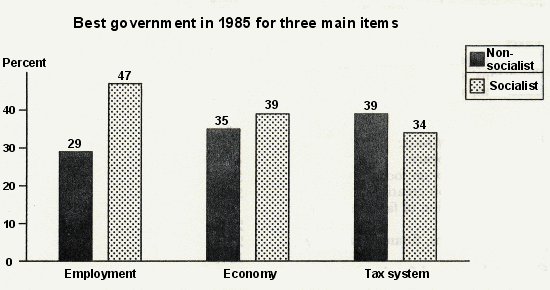
Sifo asked: "Which government do you think would be better at handling the economy — a non-socialist or a socialist government?" Prior to the non-socialist rule 1976-82 questions of this kind were commonly answered in favor of the non-socialists. The Liberals' former leader Bertil Ohlin, among others, had built up confidence in the non-socialists' acumen in handling the economy. They were then viewed as the more skilled in managing finances, and the Social Democrats were seen as skilled in handling welfare issues. But during the non-socialists' rule 1976-82 public confidence in their ability to handle the economy was eroded. The middle-of-the-road non-socialist parties — the Liberal and Center parties — received only 4 percent in 1982 when Sifo asked which party would be best at handling the economy; 27 percent named the Conservative party, which at that time was not included in the ruling coalition. Today the blocs are about even in respect to the voters' assessment of their ability to handle the economy: 39 percent believe a Social Democratic government would be best at managing the economy and 35 percent think a non-socialist government would be best. The rest, 26 percent, either have no opinion or are uncertain because they do not perceive any difference between the blocs in this respect. The Social Democratic Minister of Finance, Kjell-Olof Feldt, thus has a very narrow lead over his non-socialist counterparts in respect to the peoples' confidence, so small that it is on the verge of falling within the statistical margin of uncertainty.
The third question was "Which government do you think would be best at establishing a good system of taxation — a Social Democratic or a non-socialist government?" Our answers reveal that the voters rate the two blocs about the same in this respect, with a slight margin in favor of non-socialists: 39 percent answer that a non-socialist government and 34 percent that a Social Democratic government would be better at creating a good system of taxes; 28 percent either do not know or perceive no difference between the blocs in this respect.
Confidence in the Social Democrats as safeguarders of employment is large, but declining. In 1985 one half of all Swedes think a Social Democratic government would be best at this job. Ever since 1968 Sifo has asked the following question a few months before election day: "Which government do you think would be best suited to safeguard employment in the country a Social Democratic or a non-socialist government?" The answers are shown in the diagram below.
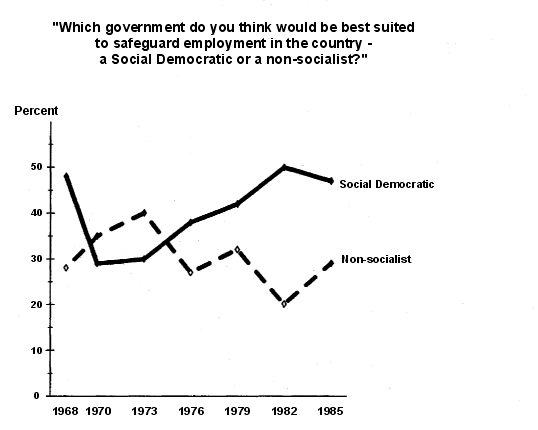
In the early '70s the non-socialists enjoyed more confidence than the Social Democrats on this issue, but since the 1976 election campaigns the Social Democrats have surpassed them. Belief in the Social Democrats as a guarantee for employment gained throughout the '70s and was strongest in 1982 when the Social Democrats returned to rule. During the current pre-election period the gap between the blocs on this issue has shrunk from 30 to 18 percent. This year 47 percent of those polled believe employment would be best served by a Social Democratic government, and 29 percent believe employment would fare best under non-socialist rule. (This is approximately the same gap as existed in 1968, the year of the last campaign of the Social Democrats' popular Prime Minister Tage Erlander.) Within the socialist bloc 86 (85) percent state "a Social Democratic government" in answer to Sifo's question, and 3 (1) percent state "a non-socialist government." Within the non-socialist bloc 60 (43) percent state that a non-socialist government would be the best guarantee of employment, and 12 (14) percent that a Social Democratic government would be best. The figures within parentheses are for the answers received in 1982. The change since 1982 is largest in the non-socialist bloc, which has regained confidence in its employment policies.
The Social Democrats launched their campaign with the slogan "Sweden is on the right road." The figures in the budget proposal which reflect an upturn in the economy and the effects of the drastic devaluation of the Crown in 1982 are impressive. And yet the voters appear to be skeptical.
Between February 20 and March 12 — when the Social Democrats' campaign was already under way — Sifo asked these questions:
|
"When you consider the economy, do you think Sweden is on the right road or the wrong road?" |
"When you consider the taxes, the public sector, and the welfare benefits provided by the State and local governments, do you think Sweden is on the right road or the wrong road?" |
|||||||
|
|
Non-social-ists |
|
|
Non-social-ists |
|
|||
|
Right road Wrong road Don't know |
41 40 19 |
26 56 18 |
64 20 16 |
Right road Wrong road Don't know |
34 48 19 |
16 70 15 |
57 24 19 |
|
|
Source: Sifo 85009/011 |
||||||||
There is considerable difference of opinion as to whether Sweden's economy is on the right road. The economy is the product of business activity as well as political activity, and its political relevance is not clear-cut. However, a majority are of the opinion that Sweden is on the wrong road in respect to taxes and public welfare. The second question is probably a better litmus test of political trends since it asks about issues that are governed by political decisions alone.
Election campaigns customarily herald every election as portentous. Yet subsequent analyses by historians and political scientists reveal that almost all elections have resulted in a political course that is close to the middle of the road in the nations concerned. Experience has shown that extreme departures to the right or left have been rare. Societal development in postwar Europe has turned out to be much the same in countries where right-wing governments have predominated (e g France) as in those where left-wing governments have been in power for the most part (e g Scandinavia).
The Thatcher and Reagan victories have often been viewed as exceptions to this rule. Policies have veered more sharply than usual from their previous course in Great Britain and the United States. Yet even in these nations such departures have loomed larger in their leader's rhetoric than in actual practice. Their versions of neoliberalism have, however, conferred greater credence to the idea that an election can lead to a real change in a socio-economic system.
One of Prime Ministe Palme's long-range goals is to be able to point to a Social Democratic victory as evidence that Sweden examined the arguments of neo-liberalism in the 1985 campaign and rejected them. The election can thus determine whether neoliberalism will be politically viable in Sweden in coming years.
In August, on behalf of Swedish TV's Channel 2, Sifo asked the following question: "Does the choice between Social Democrats and Conservatives mean a choice between two social-economic systems, or do you think the system in Sweden will be the same no matter who wins the election?"
|
|
Non-social-ists |
|
|
|
Yes, a choice between two systems No, the system will be the same no matter who wins Uncertain, don' t know |
|
|
|
Supporters of the ruling socialist bloc see the election as a choice between two different socio-economic systems: 54 percent share this view, and 31 percent are of the opinion that the prevailing system will remain in force irrespective of who wins the election. Among the non-socialist opposition a bare majority state that the election does not stand for a choice between two systems, and 51 percent think the system will remain unchanged no matter which bloc wins; the corresponding figure among Conservative supporters is 52 percent.
Note that these figures are based upon only 605 interviews, and they should be interpreted with caution.
First-time voters number 356,200. Young people are responsible for much of the growth of the electorate. The accompanying diagram shows the percentage of socialist voters among all those under 25 years of age who are entitled to vote. The diagram can be compared with the the increases for the socialist bloc shown in the previous diagram. It was the young people in Sweden who accounted for the socialists' top readings in 1968-70 and 1982.
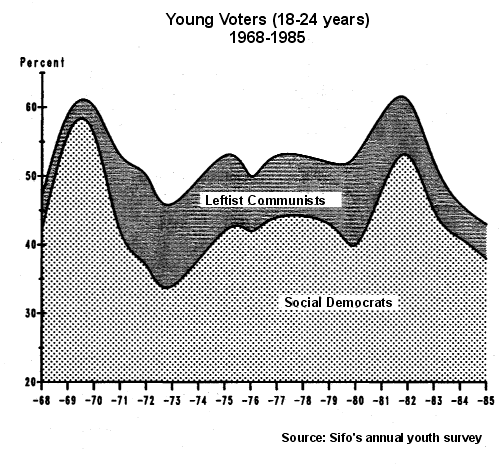
During the "red wave" of 1968-70 the socialist parties (the Social Democrats plus the Leftist Communists) gained many sympathizers among the nation's youth. The red wave included leftist criticism of the Social Democrats. Between 1978 and 1982 the Communists had considerable strength among youth: approximately 10 percent of those aged 18-24 were then Communists. At the time the Social Democrats had difficulty competing with the Communists for the allegiance of the young. The low-water mark for the Social Democrats was registered in 1973 when their party received 34 percent of the young vote and the Communists 13 percent.
Toward the end of the non-socialist government in 1980-82 the Social Democrats made significant gains among the young. By the beginning of 1982 a full 60 percent of Swedes aged 18-24 were socialists, and their vote did much to restore Palme to the office of prime minister. He then won many more votes among youth who had not yet attained the franchise when he was Prime Minister 1969-1976 than he did among adults who had had the right to vote during his previous term.
The percentage of socialists aged 18-24 has declined each year since 1982 and has now reached the lowest figure obtained since Sifo began its youth surveys in 1968. There are far fewer young Communists in the '80s compared with the '70s: today, approximately one out of twenty young people between the ages of 18 and 24 sides with the Communists. Tbe Social Democrats' following among 18-24-year-olds has also been on a downward slide since 1982. The figure for 1985 is 38 percent, which is slightly better than the low of 34 percent recorded in 1973.
Today Conservatives and Social Democrats have equal shares of the electorate aged 18-24 years. The Conservatives have support among 37 percent in this age bracket, an increase from 24.5 percent in 1982; the Social Democrats have the support of 38 percent, a decrease from 52.5 percent in the winter of 1982-83.
The two main actors are the veteran Olof Palme, leader of the Social Democratic party, and the challenger, Ulf Adelsohn, Conservative party leader.
In May and June, Sifo asked questions such as "Who do you think is . . ./more intelligent, friendlier/etc. ..., Adelsohn or Palme?"
Three questions concerned attributes of the "head":
| "Who do you think has the firmer ideological conviction?" | |
| "Who do you think is more intelligent?" | |
| "Who do you think is more knowledgeable about the Swedish people?" |
One question inquired about an attribute that can belong to both heart and mind:
| "Who do you think is more honest?" |
Three questions dealt with attributes of the "heart":
| "Who do you think is more friendly?" | |
| "Who do you think is fairer toward his opponents?" | |
| "Who do you think makes the most bitter enemies?" |
Those interviewed were also given an opportunity to summarize their impressions:
| "Who do you think has the more balanced personality?" |
A couple of questions concerned their roles as political leaders:
| "Who do you think inspires most confidence as a politician?" | |
| "Who do you think has the best relationship with his coworkers?" |
Finally we asked two questions of a more hypothetical nature:
| "If Sweden were in a major recession, who would you prefer to have as prime minister?" | |
| "If the world situation became alarming, who would you prefer to have as prime minister?" |
The accompanying diagram tells us how the electorate views the two main contenders for the office of prime minister. (The scale has been inverted for the question regarding the "most bitter enemies" so that the most positive results are always at the right of the diagram.)
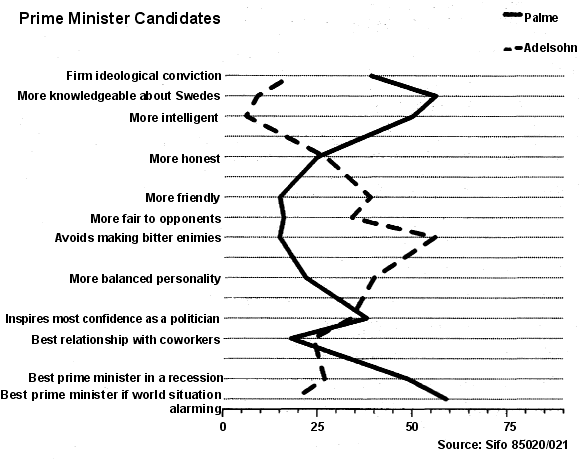
When a representative sample of Swedes between the ages of 16 and 74 are asked to judge the leading candidates for prime minister, Palme is rated highest on intellect and Adelsohn on personality.
There are four possible outcomes of the election:
By January of the election year Palme's present government had lost more support among the electorate than any of his previous governments, but since then it has recovered handsomely.
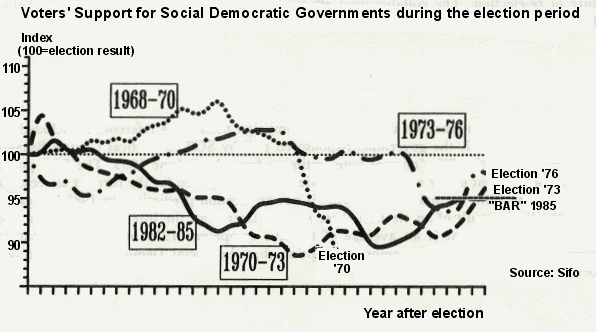
In the above diagram the election results which led to the formation of Social Democratic cabinets since 1968 have been assigned a value of 100 for purposes of comparison. We may note in passing that the curve for the present Administration (the solid line) was lower than for other Palme Administrations until five months before Election Day.
The bar that Palme has to clear to win in 1985 is the index figure 95.1 on the diagram. To continue to rule, albeit with Communist support, the Social Democrats must get 43.5-44.5 per cent of the votes. The lower number presupposes that the Communists can hold onto the 5.6 per cent they got in 1979 and 1982, and that the Green party will, as in 1982, reach less than halfway to the 4 percent barrier for representation in the Riksdag. To be more sure of continued rule the Social Democrats may need a higher number than 44.5 per cent since there is no assurance that the Greens will match their 1.7 percent and that the Communists will keep their 5.6 percent.
To rule without Communist support Palme will have to clear a bar at the level of 101. To rule with an absolute majority he has to clear a bar in the neighborhood of 106-107. The August polls show him just above the first bar.
A collaboration in campaigning that the Center party and the Christian Democratic Union initiated in the autumn of 1984 unexpectantly raised the bar the Social Democrats had to clear. The Christian Democrats, who in past elections had been excluded from the Riksdag because they never reached the minimum 4 percent, will now run on the Center ticket. This collaboration contains one important key to the arithmetic used in tallying this year's election prospects. Without the collaboration Palme would have been reasonably sure of re-election. The collaboration effectively raised the bar of re-election for Palme from approximately 42.5 to 43.5 percent.
_______________
The constitutionality of the collaboration scheme has been much debated in Sweden. The Constitution excludes minor parties receiving less than 4 percent of the popular vote from the Riksdag. By using a joint ticket with a major party — which is not unconstitutional — a minor party such as the Christian Democratic Union, which in the last election received 1.9 per cent of the votes, gets into Parliament anyway. Perhaps the final judgment on the consitutionality of the scheme can be made when we know just how much the two will collaborate in the Riksdag. If they merge or virtually merge in the Riksdag there is no consitutional issue. If the Christan Democrats choose to organise themselves as a full fledged and independent parliamentary party it will be apparent that the intention of the Constitution has been circumvented.
The shrewd rustic politicians, Fälldin (Center Party) and Svensson (Christian Democratic Union), concocted this somewhat devious scheme to beat Palme, the smart big city politician. At the time the deal was announced they said that they wanted to strengthen the "middle alternative" in Swedish politics, with an edge against both the Left and the Right. But in the event they succeed, how will they handle another big city politician, the Conservative party's Adelsohn, who, as the undisputed choice for prime minister in a non-socialist coalition, is the main beneficiary of the scheme?
The table below summarizes the published campaign polls. As a reference is included the election result 1982, the government-sponsored poll by SCB (Statistical Central Bureau) from May, and the Sifo "normal vote" estimate from April-June 1985. The SCB poll is unique on account of the number of interviews and is adjusted for the turnout as recorded in May. The "Sifo normal vote analysis" is not an election prediction for 1985 but calculates the likely result of an election three months later than the interviewing after a presumed campaign that is an average of the five campaigns 1970 to 1982. By using its numbers we can test the common assumption that the Social Democrats are running a better than average campaign, 1985.
|
Sifo polls |
Reference data |
||
|
Elec- |
Sifo |
Sifo |
|
|
m s mp, other |
23.6 45.6 2.0 |
28.2 43.9 1.3 |
28.5 45 1 |
|
(Interviews) |
(3000) |
(1000) |
|
|
Method |
Face-to-face |
Face-to-face |
|
|
Other polls |
Reference data |
Campaign polls |
||||
|
Elec tion % |
SCB Apr 29- |
Semka Aug |
Semka Aug |
Semka Aug |
IMU Aug |
|
|
m s mp, other |
23.6 17.4 45.6 2.0 |
27.6 43.7 4.7 |
24.3 44.2 4.1 |
24.8 44.6 3.8 |
25.5 44.1 3.8 |
25.2 44.4 3.1 |
|
(Interviews) |
(7150) |
(388) |
(389) |
(405) |
(515) |
|
|
Method |
Tele |
Tele |
Tele |
Tele |
Secret Ballot |
|
* * * * *
Copyright (c) 1985 Sifo Förlag AB. Reprinted by permission
.INDIKATOR
— Sifos politiska nyhetsbrev — ger opinionsledare och personer i ansvarsställning upplysningar om det rådande opinionsläget och förändringar i samhället.Ansvarig utgivare Hans L Zetterberg
ISSN-nummer 0345-5262